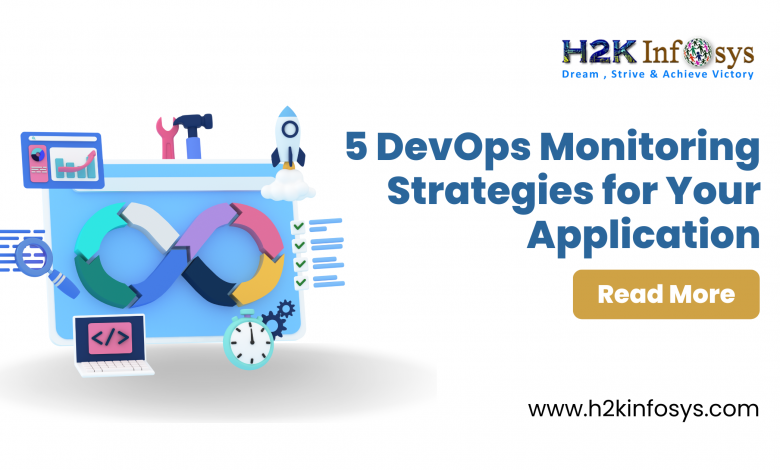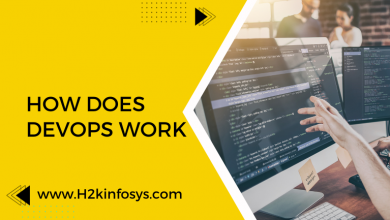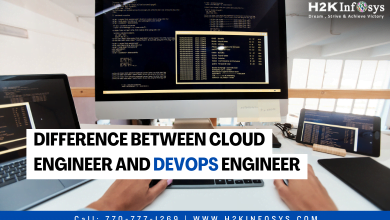5 DevOps Monitoring Strategies for Your Application

Due to its continuous integration and delivery methodology, DevOps is becoming more and more popular among businesses nowadays. Automation frequently steals the show in the field of DevOps. This is not unexpected. How come?
The most recent State of DevOps study from Puppet indicates that DevOps automation enhances an organisation’s overall efficacy.
But possibly even more so than automation, DevOps monitoring is another essential component that contributes to raising awareness at every level of the delivery pipeline. Check out the online DevOps training to learn more.
You may wish to think about a variety of monitoring-related factors: What to monitor, what tools to employ, or how to begin implementing a DevOps monitoring plan.
Although DevOps came before monitoring, the software development process has changed so much as a result of DevOps that monitoring needs to change as well. DevOps has accelerated software development overall; teams are increasingly automating testing and integration, putting software on the cloud with short turnaround times, and providing continuous delivery.
With DevOps, teams have additional parts of the project to monitor, including integration, provisioning, and deployment. To properly oversee these facets of the project, teams must employ DevOps monitoring techniques.
We have developed a generic framework to assist you in understanding where to consolidate, what to monitor, how to get started, and which tools to utilise for monitoring needs in order to help you with your DevOps monitoring strategy in a rapidly changing environment.
- Determine What You Should Monitor
What is the initial stage of a successful DevOps monitoring strategy? determining what applications you should keep an eye on. There are a few main areas into which monitoring targets can be categorised, and you should probably address at least one component of each group.
Among these categories are:
- Server Health
- Application log output
- Vulnerabilities
- Development milestones
- User Activity
Development Milestones
Tracking development milestones might help you gauge the effectiveness of your DevOps strategy. It’s a useful method for learning about your workflow and figuring out how well your team is working together. Keep track of the length of each sprint, the frequency of issue finds, reports, and fixes, as well as the proportion of features that are expected vs those that are delivered.
Ask questions like these:
- Are our deadlines being met? If not, what’s getting in the way of things?
- Is the team successfully implementing the DevOps approach?
When possible, combine monitoring technologies to expedite and simplify troubleshooting. To expand technology and maintain vendor independence, use open-source and open-licence agents.
Machine learning technologies can also help you save time by automating configuration processes.
Vulnerabilities
Vulnerabilities can be broadly classified into two categories: vulnerabilities resulting from insecure coding practices, insecure design, or insecure architecture within the application, and known weaknesses or vulnerabilities in an application that are widely known or identifiable via lists maintained by the National Vulnerability Database (NVD).
Businesses must keep an eye on these vulnerabilities and take prompt action to mitigate them. Changing third-party dependencies, holding frequent secure code reviews, training your software development team, and employing qualified experts are a few strategies to solve these risks.
User Activity Monitoring
Perhaps one of the most obvious kinds of DevOps monitoring techniques is user activity monitoring. To make sure that only authorised users can access the system, strange requests or unexpected inputs such as several unsuccessful login attempts, unusual login times, and unrecognised login devices should be continuously watched.
Also, Keeping an eye on user behaviour can aid in spotting odd activity, such as elevating access privileges. An example of this would be a developer trying to get into an admin account.
Such out-of-the-ordinary behaviour and requests could raise suspicions and increase your awareness of possible insider threats and other hacks that might arise from inadequate user activity monitoring.
Application Log Output
The task of monitoring application log output is frequently undervalued, but it becomes considerably more challenging if your services are dispersed and centralised logging is not in place.
Furthermore, faults and vulnerabilities are not very valuable if they are not found in real-time. It is crucial to make sure that malfunctioning or prone to error codes produce real-time notifications that can be readily searched. An enormous benefit is being able to track down a defect or issue in a production environment.
Server Health
Monitor the uptime and performance of your server in relation to the resources that are accessible to you. Verify that all configuration details are correct and that the scanning functions (which include detecting application vulnerabilities) are operating as planned. Certain servers are hardened according to approved configurations as well.
- Identify Monitoring Functionalities
DevOps monitoring solutions should be able to track the use of machine learning for alerting and reporting, gather performance time-series data from open-source agents, and store data in scalable time-series databases.
The following features are possible with one or more of your monitoring tools:
- Dashboards: Share pre-made, easily customizable dashboards with colleagues.
- Diagnostics: Verify that every feature is operating as planned and troubleshoot the entire application stack to find any potential vulnerabilities.
- Data Collector: Agents for all programming languages and middleware that are open-source and licensed under open licences.
- Data Retention: for log data and time-series performance data.
- Notifications: Instantaneous alerts that can be linked to instant messaging and escalation systems.
- Reports: Comprehensive analyses and reports can assist in locating planning and performance hotspots.
- REST API: Access any data, add custom data, and alter configuration using a documented API.
- Machine learning: Real-time anomaly detection and non-real-time capacity loss analysis.
- Monitor Your Full Application Stack
You should select a DevOps monitoring tool that can provide speedier troubleshooting and repair while keeping an eye on your entire stack. This list aims to include the most extensive feature sets available in an application, but it is by no means exhaustive:
Infrastructure Monitoring
A crucial element of full-stack application monitoring solutions is infrastructure monitoring.
What kinds of things should tools measure?
- Availability
- CPU usage
- Disk usage
- Uptime
- Response time
- Databases
- Storage
- Components
- Virtual systems
- Performance
- User permissions
- Security
- Network switches
- Process level usage
- Throughput on the application
- Load of the servers
They should also be able to offer a history of trends, time-series data from the measurements, and data aggregation with drill-down capabilities to the process level.
Network Monitoring
Performance measurements like latency, various port level metrics, bandwidth, host CPU utilisation, network packet flow, and the ability to assess custom metrics should all be included in network monitoring software. Network monitoring tools typically require a platform that is compatible with a variety of network topologies, including heterogeneous and cloud-based networks.
Application Performance Monitoring
Application performance monitoring is the process of searching, gathering, and centralising logs while utilising the application’s tracing and profiling features.
Additionally, it assists in providing performance metrics like throughput, availability, error rate, user response time, sluggish pages, page loads, slow JavaScript performance from third parties, track SLAs, browser speed, and end-user transaction checks.
This list is by no means comprehensive, but it should help you identify the gaps in your DevOps monitoring approach and the capabilities of the monitoring tools you currently have.
- Evaluate Monitoring Tools for DevOps Workflows
Provide a structure for an outline that DevOps teams may utilise to begin the review process.
You can focus on particular questions during review by defining goals that are relevant to your entire DevOps monitoring approach, such as:
“Does this monitoring tool satisfy my requirements and goals?”
You’ll be able to delve deeply into feature functioning during the review process if you understand DevOps monitoring tools and the functions they offer.
Making the best decision for a more focused and all-encompassing DevOps monitoring approach will be made easier with knowledge of the monitoring functionality associated with each monitoring aspect, such as application monitoring or infrastructure.
- Leverage Tools for Effective DevOps Monitoring
The top DevOps monitoring tools available right now include the following:
- Collectl: Collectl is a platform that unifies several performance monitoring tools. Numerous subsystems, including nodes, storage, CPUs, TCP, and file systems, are among those it can keep an eye on. Collectl is available in Red Hat and Debian repositories and is compatible with all Linux systems.
- Consul: Consul offers functions such as failure detection, discovery, and key-value storage in a variety of data centre scenarios. It works with current infrastructure without changing code and has an integrated DNS server for service queries.
- God: God offers a streamlined method of monitoring through the usage of a Ruby framework. It can be found on Darwin systems, BSD, and Linux. God offers a more straightforward method for creating poll events and event criteria. Additionally, it offers a personalised, integrated notification system.
- Ganglia: Ganglia makes use of a hierarchical architecture that is tailored for cluster federation. In order to implement a high degree of concurrency and minimise overhead on the node, it makes use of widely used technologies for data representation and transmission, such as XDR and XML, in addition to a special data structure and algorithmic methodology.
- Nagios: For Unix, Linux, Windows, and web environments, Nagios offers application, network, and server monitoring through a blend of agentless and agent-based software solutions. The system provides availability, response, and uptime via a variety of reporting formats and visualisations.
Conclusion
Businesses must develop and put into practice efficient DevOps monitoring plans. Faster development procedures in DevOps present a number of difficulties, particularly with regard to potential weaknesses and vulnerabilities in the system that may remain as a result of hurried processes or inadequate testing.
Having effective and scalable DevOps monitoring techniques will enable you to learn more about your application, spot any problems early on, and take steps to minimise them. Recall that you must assess every facet of your application or project, even though some areas of monitoring may be more crucial for your company than others. To learn more, you can check out the DevOps course online.





